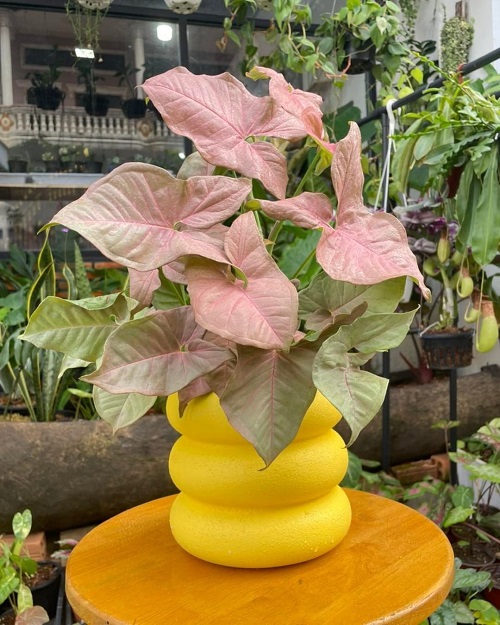Learn all about Growing Syngonium Pink Allusion Indoors and add a pop of pink to your indoor jungle with its stunning foliage!

Native to the tropics of South and Central America, Syngonium Pink Allusion is prized for the striking pink-green variegation it offers. Apart from its beauty, the plant’s low demands make it a fantastic addition to homes, offices, and co-working spaces. Learn everything about growing this gorgeous houseplant with this care guide!
- Botanical Name: Syngonium podophyllum ‘Pink Allusion’
- Popular as—Goosefoot Plant
- Attains a height of 2 feet indoors
- Thrives in a temperature range of 60-85°F (16-29°C)
- Toxic to humans and pets
Learn about Growing Syngonium aurea here
Syngonium Pink Allusion Profile
Member of the Araceae family, Syngonium Pink Allusion features arrow-shaped leaves that emerge with a pale pink coloration and gradually mature to a darker shade with green undertones. The glossy texture and velvety finish give them a soft, delicate, and dusty look. Additionally, the species—Syngonium podophyllum is a natural source of antioxidants that are effective in the treatment of oxidative stress-related disorders.
Standing at a decent height of 2 feet, the plant has a compact and bushy growth habit, making it an excellent choice for small spaces or as a decorative accent on shelves or tabletops.
Syngonium Pink Allusion vs Neon Robusta
Both the tropical beauties are fantastic houseplants hailing from the Araceae family and are native to tropical regions of Central and South America. However, there are some notable differences between the two.
Syngonium Pink Allusion flaunts heart-shaped leaves with pinkish veins and a subtle green background, giving it a soft, delicate appearance. The leaves emerge with a pink hue that gradually fades to a lighter shade as they mature. While Syngonium Neon Robusta boasts vibrant, neon pink leaves that are more on the heart-shaped side than arrow-like compared to other Syngonium species.
Pink Allusion tends to have a slightly slower growth rate compared to the Neon Robusta, which can grow more quickly under optimal conditions.
Caladium vs Syngonium? Click here
Syngonium Pink Allusion vs Pink Splash
Syngonium Pink Allusion and Syngonium Pink Splash are two distinct cultivars from the same genus that feature different color patterns and variegation.
Pink Allusion features delicate, heart-shaped leaves with pink veins and a subtle green background. The pink splashes tend to fade over time, giving the plant a soft, elegant appearance. In contrast, the latter has a more pronounced variegation, with leaves featuring patches of bright pink, green, and cream colors.
Both cultivars are relatively low-maintenance plants. However, Syngonium Pink Splash may require slightly more attention to maintain its vibrant coloration, as inadequate light can cause the variegation to fade.
Syngonium Pink Allusion Propagation

Propagating Syngonium Pink Allusion through stem cuttings is an easy and rewarding process. Follow these steps to propagate your plant successfully:
- Select a healthy and mature stem from a disease-free plant, ideally with at least 2-3 leaves and aerial roots.
- Make a clean cut below a node at a 45-degree angle using sterile clippers, leaving at least one node on the cutting.
- Remove any leaves close to the cut end, leaving only 1-2 leaves at the top of the cutting.
- Dip the cut end of the stem into a rooting hormone powder, brushing off the excess.
- Prepare a small pot with a well-draining, moist potting mix, and insert the cut end of the cutting into the soil, burying the node.
Place the cutting in a warm, bright location with indirect sunlight and avoid exposure to direct sunlight, as it can cause the cutting to dry out and impede root development. Also, keep the soil consistently moist but not soggy. You’ll find new roots developing within 3-4 weeks.
Syngonium Pink Allusion Growing Requirements

Light
Syngonium Pink Allusion thrives in bright, indirect light. A spot near an east- or north-facing window is ideal, or using sheer curtains to filter sunlight from a south- or west-facing window will also provide the plant with the optimal condition. Avoid exposure to direct sunlight, as it can cause scorching and damage the delicate leaves.
The plant will continue in low lights as well, but the vibrancy may go dull and with a slower growth rate.
Soil
A well-draining soil mix is crucial for the health of Syngonium Pink Allusion, as it prevents root rot caused by excessive moisture. Combine a high-quality potting mix containing peat moss, perlite, or vermiculite. Alternatively, you can create your own mixture by combining equal parts peat moss or coco coir, perlite, orchid bark, or coarse sand. Ensure the pot has drainage holes to allow excess water to escape.
Water
Syngonium Pink Allusion prefers evenly moist soil but is sensitive to overwatering. Water the plant when the top inch of the soil feels dry to the touch. Follow a weekly deep watering session and saturate the medium thoroughly, allowing excess water to drain from the pot. This will prevent root rot while providing the right moisture.
Reduce the watering frequency during the cooler months as the plant enters a period of dormancy. Water only if you find the foliage drying up or the plant showing shriveled growth.
Temperature
Syngonium Pink Allusion grows best in temperatures ranging from 60-85°F (16-29°C). It is sensitive to cold drafts and sudden temperature fluctuations, which can cause leaf drop. Keep the plant away from air conditioners, heaters, and drafty windows to maintain a stable temperature.
If the temperature drops below 50°F (10°C) for an extended period, the plant may experience stress and slowed growth.
Humidity
Native to tropical regions, Syngonium Pink Allusion prefers a relative humidity of 50-60%. To maintain adequate humidity, place a tray filled with water and pebbles under the pot, ensuring the water does not touch the bottom of the pot. Alternatively, you can use a humidifier or group the plant with other humidity-loving plants to create a microclimate.
Misting the leaves with water can also help increase humidity but may not be sufficient on its own.
Syngonium Pink Allusion Care

Fertilizer
To support healthy growth and vibrant foliage in Syngonium Pink Allusion, feed it with a balanced liquid houseplant fertilizer, such as a 20-20-20 or 10-10-10 formulation. Dilute the fertilizer to half strength and feed the plant every 4-6 weeks to avoid over-fertilization, which can lead to nutrient burn and damage to the plant.
Also, do not fertilize the plant in its dormancy during the cooler months
Pests and Diseases
Syngonium Pink Allusion is generally a resilient houseplant but can still fall victim to aphids, spider mites, mealybugs, and scale insects. These pests can cause yellowing, wilting, and curling of leaves, as well as reduced vigor and overall health.
Inspect the plant regularly and spray the undersides and nodes of the leaves with insecticidal or neem oil solution. You may also use a cotton swab dipped in rubbing alcohol to remove the pests or wash the plant with a mild soap solution to clear dust or dirt accumulation.






